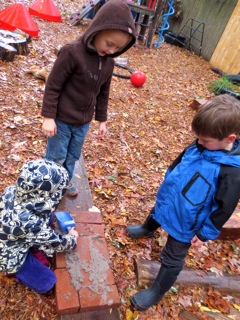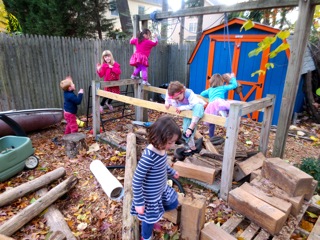This is what children will actually do...
"What happened?" The children suddenly stopped short when they ran outside to play and found the loose parts platform they have been using as a pirate ship-dragon lair-princess castle dismantled. The planks were lined up 1-2-3 along the ground. Earlier, I had asked one of the co-opers to move away the planks after he dropped off his older son at school. I knew it was going to rain that day. The platform is so popular and we are still working out our risk assessment for its use on certain shift rotations. With the rain-slick surface of the boards, I knew it would actually be safer to dismantle it for the afternoon. There are two sides to a coin. On one side is a dismantling and this is not a sign of failure of our system, it's a measure of its success. The other side of the coin is even better -- removing the planks opens up new possibilities. And when the children arrived on the scene later that day, it took only seconds for them to spring into action!
"We need to build it back!" and "We need a big crew for this!" The children shouted. The rain had soaked the boards through and through. They picked up the biggest one first. Of course. And with a heave ho, fingers gripping, they carried it away from the loose parts structure. That's right. Away.
They set it down. And looked at it. They looked back at the other two planks. They rallied and picked up the second one. They moved this one away as well. But, see they didn't mean to move them away. They meant to rebuild the platform. Each time they moved a board and set it down they would look at it surprised that they had not moved it back to the platform and that it was not sitting exactly back where they thought it belonged.
This is what young children, without the help of older children or adults, will actually do when building with planks, crates, or branches. And this is how young children become those older children and adults -- by moving things away rather than systematically towards.
This very thing is described so wonderfully in Unnur Henrys' guest post, The Christmas Tree <click here>. Young children see Christmas trees standing upright and this makes all the sense in the world. So when thinking about how to pull a tree to the top of a play structure, they would naturally pull it and push it treetop up. An adult knows to turn the tree upside down and carry it and pull it up by its trunk. An older child will figure that out after a few tries. Young children will work and work and work when left alone, and more often accomplish very little as far as actual cohesive construction is concerned. And they will mostly be quite happy about the task at hand. With adult- or older child-help, of course, we arrive at our loose parts constructions like branch teepees and large den structures.
The best part of this story goes back to the other side of the coin, the one that features possibilities. As with with Unnur's story about the Christmas tree, young children left to their own pursuits will discover things that adults don't readily see. Once the children figured out that the boards were not getting any closer to the loose parts structure, the children turned their attention to the cache that had been deposited "below deck." Below deck is what they called the place under the planks. They had thrown every bit of material they could collect under there. It was at least 2' deep in bark, bricks, and branches. They uncovered the bricks and the discovered the word, "debris." They found that this word was quite useful in their play.
The princesses moved into their ruined castle. A dragon lurks just outside waiting. This is a perfect castle for resourceful young princesses and anyone can see that a dragon will never find its way inside! You can also see from the photograph above that the debris is spreading, not collecting. This is what young children will actually do...spread things more effectively than we could imagine possible.
Later, once the play from this winds down and by drawing inspiration from the children, a new construction plan may be hatched. We know and own that the adult hand will be in it. Somewhere. For now, this debris field is exactly right and it is perfect because it is theirs.




